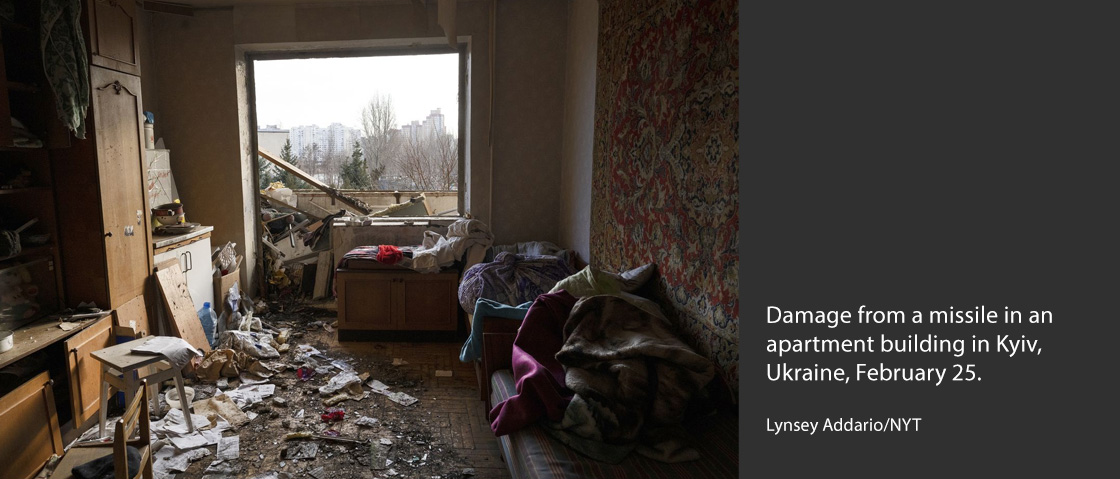TikTok is undoubtedly playing multiple roles in this war. One of which is that the war and its accompanying acts of brutality are being documented and disseminated across the world.
Ukrainian TikTokers, at home and abroad, have been livestreaming, recording, and sharing everything from the banal to the brutal since Russia invaded Ukraine.
The Ukranian content creator who has me hooked lives in Kyiv with her 2-year-old daughter. Her most-watched TikTok is not so different from the billions of other videos that populate the Chinese app: She can’t sleep, so she’s recording a video from bed to share her fears and anxieties — teenagers across the world do this routinely. What makes Kristina stand out is the fact that she can’t sleep because she feels explosions shake her house. “This might be the beginning of something serious,” she says. Her shaky voice is backdropped with gentle piano music that she’s added for a haunting effect. A large part of TikTok’s ethos is that videos are built around music.
Seeing war survivors in photographs and videos is not novel. Yet TikTok allows viewers to watch survivors record themselves — and then step behind their cameras to show us what they see. Garmoniya, a TikToker reportedly from Donetsk in eastern Ukraine, posted glamorous videos of herself until a month ago. Now she is in a war zone. In an earlier TikTok, she showed us that an explosion had shattered her bedroom window — there were shards of glass everywhere. In the video, a translator informs us that the window has been replaced, but it doesn’t fit exactly right, there’s a slight draft. You can hear Garmoniya laughing as she talks about the window. Is she laughing at the absurdity of war, happiness for her new window? A lot of TikTok is like this: In exchange for direct access to people’s emotions and viewpoints, for removing the journalist in the middle, viewers sacrifice other details.
Despite this, I continue to scroll — and pause on faces that have now become familiar to me — because the app allows me to interact with those under siege. On Sunday, a Donbas man living in a bunker with a dog and two cats conducted a livestream. He left his dimly-lit bunker to have a smoke outside in the dark. Thousands of viewers stayed, patiently waiting while he finished his cigarette. “What are you feeling?” I typed when he returned to the bunker. “I’m scared because even when this war is over, the trauma, the mines, and the tanks will be here,” came the response. His reply was unedited, unfiltered.
There is no doubt that TikTok is also being used to spread misinformation and disinformation. The app’s structure makes it easy to overlay old audio onto current videos, causing misleading videos to be unintentionally amplified by users. Some users attempt to pass footage from video games, training manuals, or old war films as live. Sifting truth from lies is not easy, but helpful users disseminate tricks and leave messages to help catch fake videos.
There is no dearth of absurd content related to the ongoing war. Videos describing how to turn your American home into a nuclear bunker. Soliloquies describing the history of Russia and Ukraine, in which Vladimir Putin is described as a husband willing to go to any lengths to take back his former wife (Ukraine). The adulatory reactions to TikToks of Ukrainians making Molotov Cocktails are hypocritical — no non-white group of people making bombs for self-preservation has ever received widespread encouragement from the West.
TikTok is undoubtedly playing multiple roles in this war. One of which is that the war and its accompanying acts of brutality are being documented and disseminated across the world. In her 2002 New Yorker article “Looking At War,” Susan Sontag wrote, “[M]any critics have suggested that the agonies of war . . . have devolved into a nightly banality. Flooded with images . . . we are losing our capacity to react.” Will taking in all this content just make us numb? Perhaps what is different about TikTok is that, while documenting, many of the creators are making requests. As television watchers, all we could offer was compassion until the next conflict distracted us, but these creators are asking for sanctions of Russia, for a no-fly zone over Ukraine, and for our protracted attention.
I have absorbed so much content from Ukraine in the last week. When I sleep, I dream about the Ghost of Kyiv — an unconfirmed myth about a Ukrainian fighter pilot who shot down six Russian planes. I wake up and check Kristina’s feed to see if there is new content. But that doesn’t mean that I understand any of what they are feeling. Sontag wrote, “We don’t get it. We truly can’t imagine what it was like. We can’t imagine how dreadful, how terrifying war is — and how normal it becomes. Can’t understand, can’t imagine.” I can converse with these men and women, hear their thoughts in real time, see the shattered glass in their bedrooms, but the distance between our realities isn’t dissolved. We can recognize their wretched fear mixed with hopeful patriotism, but that doesn’t mean we get it.
Maham Javaid is the 2022 Elizabeth Neuffer Fellow at the International Women’s Media Foundation and a research fellow at MIT’s Center for International Studies.




